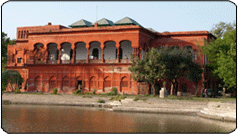Baradari, Picture gallery, Clock Tower of Hussainabad
Among the three heritage zones designated for the city of Lucknow, one is the Hussainabad area extending from the great (Bara) imambara of Asaf-ud-Daulah to Jama Masjid via Chhota Imambara. The State Heritage Task-force met recently and mooted the development of the Picture Gallery and the adjoining Hussainabad area.
In fact the term 'Picture Gallery' is a misnomer because the gallery is housed in a small part of the pink and terracotta coloured building that was built by the third King of Awadh, Mohammed Ali Shah (1837-1842). The double storeyed building is referred to as a Baradari in contemporary accounts. In front of the Baradari, a talaab (water tank) was built an year after its completion around 1839. A small mosque and a matching hamam (bath) were also built at the two corners of the talaab (water tank). A serai (inn) and a Mina bazaar (market) were constructed in front of the Baradari alongwith a feelkhana (stables for elephants) and astabal (stables for horses).
A unique feature of the Hussainabad Baradari is the fact that it contains iron pillars in the upper storey pavilion facing the talaab and this had been used thus for the first time in the Nawabi buildings.
Mohammed Ali Shah also built a Gendghar (bowling alley) close to the Baradari, for the amusement of his British friends, the Resident and officers of the East India Company [it is no longer extant].
In fact, the credit for the inception of Hussainabad (which was earlier known as Jamania Bagh because of an enclosed garden) and its development goes to Mohammed Ali Shah. He also constructed a metalled road connecting the two Imambaras between Rumi Gate and Hussainabad gateway.
After the annexation of Awadh, some of the buildings of Hussainabad were destroyed by the British, but they appear to have made amends by additions and alterations in and around the Baradari complex. Towards the Rumi Gate, on the east where the Daulat Khana of Asaf-ud-Daulah earlier existed, they built a 67 metre (220 ft.) high Clock Tower, as a symbol of their superiority [though the construction of this Clock Tower was actually funded by the Hussainabad Endowment Trust, which was then under their control]. Built around 1881, the Clock Tower was designed by Roskell Bayne in the Victorian Gothic style. According to Philip Davies author of Monuments of India, it carried the largest clock in India.
For some time the Baradari of Mohammed AN Shah was known as the Taluqadar Hall, when it was handed over to the Anjuman of Taluqadars of Awadh by the British. However, later it was used as a 'Picture Gallery' that displayed [large full length] portraits of the Nawabs of Awadh that had been painted between 1882-1885 by visiting European artists [Harrison, Dawling and Gravet and one Indian artist D.S.Singh]. The gallery, with further addition of photographs of administrators and officials of the Colonial period, exists there even today [it is open for visitors].
Source:
Hindustan Times, City Scan, A Time in History
Wednesday 6.5.1998 — Hussainabad Monuments-Preserving an arty heritage

